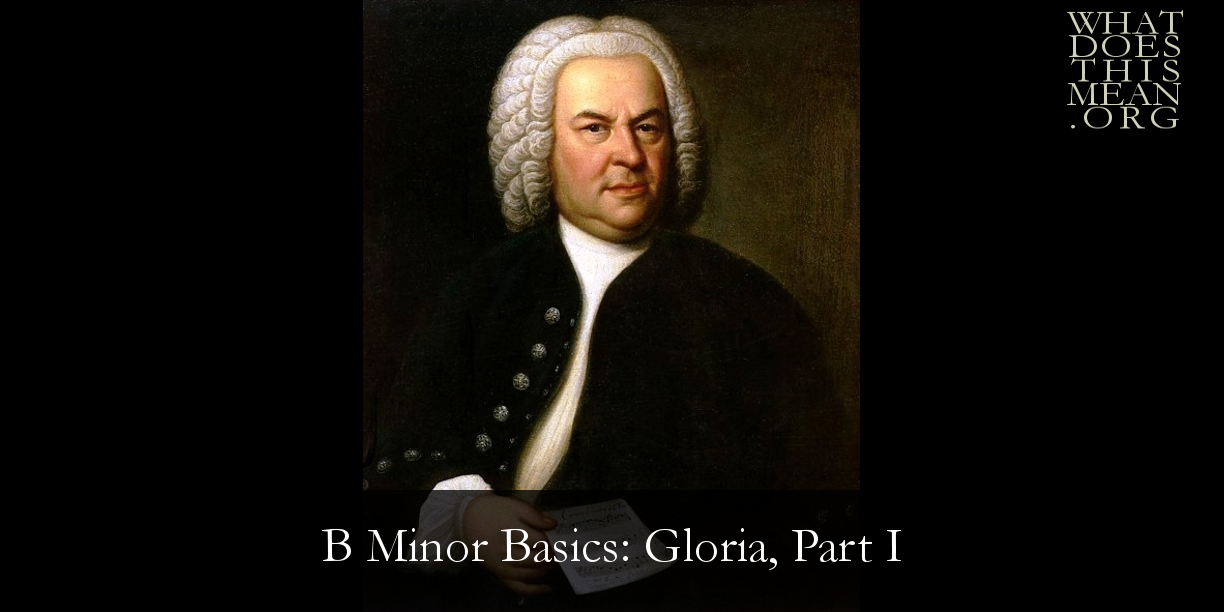And the kingdom and the power and the glory are in His hand.
The transition from the Kyrie to the Gloria gives the composer a unique opportunity for contrast, and Bach makes the most of it in the B-Minor Mass. He employs the trumpets and timpani and exchanges the softer sounds of the oboes d’amore for the more powerful oboes d’caccia. His compositional technique shifts to the concertato technique, which employs virtuosic elements for every member of the orchestra, along with demanding writing for the choir and soloists. Instead of the F-sharp minor of the second Kyrie, Bach switches to the radiant “Trumpet Key” of D Major. (Look for three natural trumpets in the following video, featured in an orchestra of period instruments that is similar to the one Bach would have known in his day, although the chorus is much larger than Bach’s original forces.) Finally, the meter shifts from a duple meter (i.e., a meter that facilitates a pulse or 2 or 4 beats per measure) to a lively, 3/8 meter, that is usually performed fast enough to feel like one beat per measure.
| Gloria in excelsis Deo Et in terra pax Hominibus bonae voluntatis | Glory be to God on high And on earth peace, To men of good will. |
The text of Laudamus Te is perfectly symmetrical: four verbs in the first person plural (“We praise,” “We bless,” etc.), followed by the simple te (“You” or “Thee”) to indicate God as the object of our praise. Here Bach employs a very demanding aria, featuring a symmetrical relationship between the mezzo soprano and the solo violin, who function as equal partners with equally demanding music. Listen for the overlap and interplay between the two soloists, conveying an unmistakable sense of joy in this beautiful performance (including the Gratias agimus tibi) from the balcony of St. Thomas Leipzig, where Bach served as Kantor from 1723 until his death in 1750.
| Laudamus te, benedicimus te. Adoramus te, glorificamus te. Gratias agimus tibi propter Magnam gloriam tuam. | We praise Thee, we bless Thee, We Worship Thee, we glorify Thee We give thanks to Thee for Thy great glory. |
Domine Deus presents a unique opportunity to the composer. As you survey the text below, you can see the transition from the initial focus on God the Father to the first explicit mention of God the Son in the Gloria. The textual shift is facilitated by using Domine (“Lord”) as a title for the Father and the Son: Domine Deus (“Lord God” [the Father]), Domine Fili unigenite (“Lord, the only-begotten Son” [of the Father]), and Domine Deus (“Lord God,” [the Son]). Bach sets this text to a duet for Soprano I and tenor, with interludes for flute solo, accompanied by muted strings. The overlap and interplay between Soprano I and tenor no doubt depict the mutual indwelling of the Father and the Son. The flute is often used to symbolize the Holy Spirit, which might be the case here. The muted strings seem to form an angelic “halo” around the Son, reminding us that God’s true glory is to live with us in Christ.
| Domine Deus, Rex coelestis, Deus Pater omnipotens, Domine Fili unigenite, Jesu Christe altissime Domine Deus, Agnus Dei, Filius Patris. | O Lord God, heavenly King, God the Father Almighty. O Lord, the only-begotten Son, Jesus Christ, the most high, O Lord God, Lamb of God, Son of the Father. |
+++



 RSS Feed
RSS Feed
